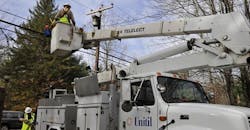Partial Discharge And Electromagnetic Interference to Identify Defects
The Davey Resource Group’s (DRG) strategic partner Exacter is being used by utilities to assess the condition of overhead distribution equipment and evaluate the probability of failure. This allows utilities to proactively increase system reliability by replacing equipment before they cause an outage. Many utilities do not have proactive programs to detect such issues, and therefore wait until there has already been an outage to replace faulty equipment.
Exacter detects the arcing and tracking of contaminated or damaged equipment before they would otherwise be detected by infrared cameras. These predictive measures then allow the utility to plan the replacement of the overhead equipment outside of peak hours, before an outage occurs.
While infrared cameras and visual inspections are often used to determine the likelihood of component failure, Exacter utilizes radio frequency, which boasts various benefits and can deliver a clear picture when used in conjunction with the other two solutions. One such advantage is that it can pick up on the deterioration of overhead equipment before it begins emitting heat, which is key for infrared cameras. This is especially helpful when insulators or cutouts are being examined as they do not emit heat even if they are nearing failure. It is well into the process that the equipment begins giving off heat signatures. This targeted, proactive approach allows the installation to be scheduled at a strategic time.
The DRG has been leveraging this technology as an asset for utilities, giving them better control of their down times and reducing customer outages because of equipment failure.
Recently, the DRG has employed Exacter to help Penelec prevent insulator failures. According to Wallace Cunningham, Penelec Energy Delivery Operation Services manager of engineering, the DRG had used Exacter on a smaller scale in three previous projects that had widened the scope for this latest initiative, covering 1800 miles of three-phase distribution lines to inspect all types of equipment conditions. After they defined the circuit they wanted examined and drafted a formal program detailing the scope and projected improvement, vehicles equipped with Exacter that can efficiently survey large areas, drove around the specified zone, collecting data. The data was then sent to the Failure Signature Library, where false positives and unrelated data from the environment were weeded out to produce a more accurate picture of which poles needed closer examination due to arcing, leaking, or tracking.
Certified ultrasonic scanners performed field locating, determining exactly which piece of equipment was emitting the radio frequency detected in the vehicle. The utility was then provided with the information, which populated their geographic information system (GIS) with the failure signature events for those pieces of equipment with problematic conditions. On average, the DRG was able to find one piece of equipment in a state of irrevocable deterioration every 5.59 miles for a total of 322 components identified. A criticality measure was also provided, which identified the potential customer minutes of interruption (CMI) an item would cause by failing, allowing Penelec and other clients to prioritize action items.
You can’t put a price on customer service and for utilities reliable service is the cornerstone of maintaining positive public relations and commission ratings. Knowing what overhead equipment is contaminated or damaged means that Penelec will have the time to schedule the replacement of those parts during times of low usage, increasing efficiency as multiple components detected in a close area would receive maintenance at the same time. Penelec plans to replace all the electrically eroding pole hardware this summer, expecting to see improved reliability in distribution equipment failures. This would keep the power running during peak times when people would need to keep the lights on.
Exacter is leveraging technological advancement for the improvement of utility reliability and the outcomes have been highly constructive. Clients have been satisfied with the results that Exacter has had on their utility lines and circuits show no less than a 20% improvement in reliability after a year with the program, given the processes recommended by the DRG were completed. This is because Exacter provides the utility with actionable items based on probability, risk and impact, which allows them a greater degree of management.
The increased control that Exacter provides should help utilities improve their reliability metrics and change how they view maintenance going forward. The DRG is looking forward to seeing how this will positively affect Penelec.
About the Author
John Markel
John Markel is a project developer at Davey Resource Group.
